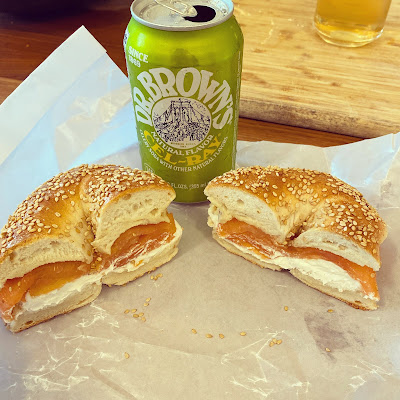In the refrigerators of New York City bodegas, you can often find cans of Dr. Brown's black cherry soda, root beer, cream soda, and ginger ale. But what a thrill it is to spot a pop of bright green among the ranks: the elusive Cel-Ray, a historic New York City celery soda also known as "Jewish champagne." At some Jewish delis and appetizing shops, Dr. Brown's Cel-Ray's shelf space is so sacred that it is labeled, to make sure its slots are not usurped by a pushy Dr. Pepper.
Though you can, of course, buy Cel-Ray online, I headed to the most authentic source I could think of: Gottlieb's Restaurant, in South Williamsburg. The circa 1962 delicatessen and cafeteria is one of the few remaining glatt kosher delis in the United States, and adheres to the strictest kosher standards.In the midcentury dining room—complete with wood-paneled walls, sconces, and tiled fluorescent lights—the coat rack was topped black shtreimel hats and draped with long black coats. A pair of tourists provided the only spot of color among the customers, though they had ignored (or hadn't noticed) the "No shorts, no sleeveless" dress code posted by the door.
According to Arthur Schwartz's New York City Food: An Opinionated History of More Than 100 Legendary Recipes, Cel-Ray was developed in 1869 by Dr. Brown, a physician from the Lower East Side. Though the soda had the same basic ingredients then as it does today—celery seed extract, seltzer, and sweetener (now high-fructose corn syrup)—it was reportedly so thick it was hard to swallow, earning the drink its original salubrious name "Dr. Brown's Celery Tonic." The tonic, which was doled out by the spoonful at New York pharmacies, was intended to soothe digestion and nourish immigrant children. But the US government didn't think it quite made the cut as a bonafide health tonic, and the name was changed to "Cel-Ray." In the early nineteenth century, celery was considered a superfood. Celery extract appeared in everything from soaps to chewing gum; there were even special glass vases and "boats" intended to display the fashionable herb around the home. Furthermore, carbonated beverages were coming into their own with the invention of new bottling technologies, and it was discovered that bubbles helped Dr. Brown's thick tonic go down more easily. Jewish immigrants with experience in beet-sugar processing in their home countries found ready employment in the burgeoning US soda industry, and Dr. Brown's Cel-Ray soda took off.
I brought my knish and can home and popped the tab. The liquid fizzing into the glass was golden, like ginger ale (did I imagine a faint green palor?), but had the distinct cool, clear, vegetal aroma of celery.
The celery scent disappeared with the first sip, however. The taste was like honeyed water that tingled on the tongue, though the sweetness was undercut by the botanical notes and a slightly bitter aftertaste, with an effervescence that seemed to be searching around for something to pair with. So I cut into the knish and popped a warm, unctuous bite into my mouth, followed by a swig of Cel-Ray. The knish was greasy and salty, the tonic cool and vanilla-laced and slightly peppery. The carbonation cut through the heaviness of the hunk of dough and potato, and the yeasty smell of the pastry was offset by the tang of the drink. It was the perfect pairing.
A few days later, I called Shelsky's a modern Jewish deli in Park Slope, catering to the bagels-and-lox crowd. When I asked if they carried Dr. Brown's Cel-Ray, the guy on the phone said, "You bet we do. It's my favorite item on the menu."










